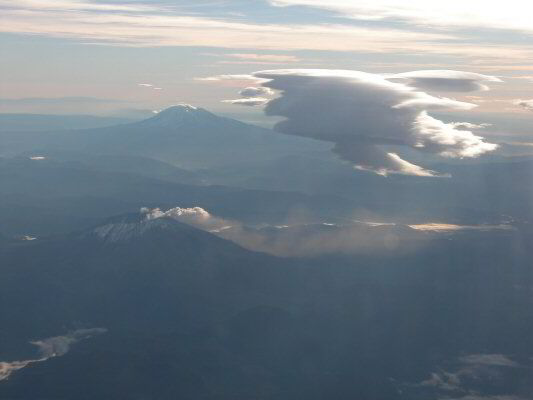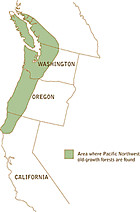Pacific Northwest Region

photo by Don Bertolette
On March 14, 2010 the Eastern Native Tree
Society and Western Native Tree Society switched from discussion lists
on Google Groups to a new discussion list in a Bulletin Board format at:
http://www.ents-bbs.org/index.php Posts made since the inception
of the BBS on March 14, 2010 will be sorted and archived on the BBS.
Click on the link to go to the equivalent section on the new BBS. This
website will continue to serve as a front end for the ENTS and WNTS
groups. It will continue to serve as a repository of older posts, and
will serve as the host site for special projects and features that are
not well suited for a BBS format. Please visit the BBS for the latest
information and trip reports.
 Pacific Northwest Old Growth Forest The Pacific Northwest old-growth forest is a conifer forest, dominated by large, old trees. In the Pacific Northwest, the most common type of old-growth ecosystem is forests dominated by Douglas-firs and western hemlocks, generally 350 to 750 years old. The youngest old-growth forests are 200 years old, and the oldest are about 1,000 years old.- The Pacific Northwest also has old-growth forests dominated by Sitka spruce and western hemlock, along the Pacific Coast, and at higher elevations in the Cascade Mountains, true fir and hemlock old-growth forests.
Pacific Northwest Old Growth Forest The Pacific Northwest old-growth forest is a conifer forest, dominated by large, old trees. In the Pacific Northwest, the most common type of old-growth ecosystem is forests dominated by Douglas-firs and western hemlocks, generally 350 to 750 years old. The youngest old-growth forests are 200 years old, and the oldest are about 1,000 years old.- The Pacific Northwest also has old-growth forests dominated by Sitka spruce and western hemlock, along the Pacific Coast, and at higher elevations in the Cascade Mountains, true fir and hemlock old-growth forests.

 Where the Pacific Coast Old-Growth Forests Are Found
http://www.fs.fed.us/pnw/forests/west-cascade/douglas-fir/mature/location.shtml
The Pacific coast old-growth forests are found only in parts of western
North America--the area from southeast Alaska and southwest British
Columbia, down through western Washington, western Oregon, and the edge
of northern California; and from the Pacific Ocean inland to the crest
of the Cascade Range. Old-growth forests do not cover all the land in this area. Many of
the forests are younger. Other types of ecosystems are found in the
valleys and along rivers. Where the Pacific Coast Old-Growth Forests Are Found
http://www.fs.fed.us/pnw/forests/west-cascade/douglas-fir/mature/location.shtml
The Pacific coast old-growth forests are found only in parts of western
North America--the area from southeast Alaska and southwest British
Columbia, down through western Washington, western Oregon, and the edge
of northern California; and from the Pacific Ocean inland to the crest
of the Cascade Range. Old-growth forests do not cover all the land in this area. Many of
the forests are younger. Other types of ecosystems are found in the
valleys and along rivers.
 Native Forest Network http://www.nativeforest.org/
The Native Forest Network is a global autononomous collective of forest
activists, indigenous peoples, conservation biologists and non-governmental
organizations. It functions on a consensus basis, and is non-violent,
non-hierarchical and non-patriarchal. Furthermore, it is non-discriminatory
on grounds of race, gender, culture, class or species. Mission: To protect
the world's remaining native forest be they temperate or otherwise, to
ensure they can survive, flourish and maintain their evolutionary potential.
Native Forest Network http://www.nativeforest.org/
The Native Forest Network is a global autononomous collective of forest
activists, indigenous peoples, conservation biologists and non-governmental
organizations. It functions on a consensus basis, and is non-violent,
non-hierarchical and non-patriarchal. Furthermore, it is non-discriminatory
on grounds of race, gender, culture, class or species. Mission: To protect
the world's remaining native forest be they temperate or otherwise, to
ensure they can survive, flourish and maintain their evolutionary potential.
 DIVERSITY AND STATE OF FOREST ECOSYSTEMS IN THE PACIFIC NORTHWEST
by Yaroslaw Medwidsky http://www.forestry.toronto.edu/usa/all%20papers.htm
The Pacific Northwest has a tremendous wealth of natural resources with spectacular forests, expansive rangelands, and plentiful salmon, having drawn people from throughout the country for more than a century (Smith et al. 1995). The complex
physiography, geology, soils and climate of the Pacific Northwestern United States (US) (Kolb and Bailey 2003) have created conditions conducive to such biotic and genetic
diversity...Physiography and Forest Ecosystems of the Pacific Northwest Region: There are four primary ecosystems in the Pacific Northwest region: forest ecosystems west of the Cascade Range (commonly called the Westside); forest ecosystems east of the Cascade Range (commonly called the Eastside); Eastside rangeland ecosystems; and riparian and aquatic ecosystems containing anadromous fish populations (Smith et al. 1995).
DIVERSITY AND STATE OF FOREST ECOSYSTEMS IN THE PACIFIC NORTHWEST
by Yaroslaw Medwidsky http://www.forestry.toronto.edu/usa/all%20papers.htm
The Pacific Northwest has a tremendous wealth of natural resources with spectacular forests, expansive rangelands, and plentiful salmon, having drawn people from throughout the country for more than a century (Smith et al. 1995). The complex
physiography, geology, soils and climate of the Pacific Northwestern United States (US) (Kolb and Bailey 2003) have created conditions conducive to such biotic and genetic
diversity...Physiography and Forest Ecosystems of the Pacific Northwest Region: There are four primary ecosystems in the Pacific Northwest region: forest ecosystems west of the Cascade Range (commonly called the Westside); forest ecosystems east of the Cascade Range (commonly called the Eastside); Eastside rangeland ecosystems; and riparian and aquatic ecosystems containing anadromous fish populations (Smith et al. 1995).
 |
Smith, J.P., Collopy, M.W., Bury, R.B.,
Castellano, M.A., Cross, S.P., Dobkin, D.S., Hagar, J., Lattin, J.D., Li, J.,
McComb, W.C., Martin, K.J., Miller, J.C., Molina, R., Perkins, J.M.,
Pyke, D.A., Rosentreter, R., Smith, J.E., Starkey, E.G., Tesch, S.D. 1995. Status and Trends of the Nationís Biological Resources. U.S. Geological Survey
(USGS) Report. U.S. Geological Survey (USGS) Biological Resources Division Report.
|
|

 Where the Pacific Coast Old-Growth Forests Are Found
Where the Pacific Coast Old-Growth Forests Are Found
